5 Bullet-Proof Questions to Make Customers Say Yes to Your Prices (even if they planned to lowball you)
Today, I’m going to show you the strategy behind 5 questions that lead to more “Yeses” to your offers and less lowballing.
In a world of:
• ever-shrinking budgets
• increasing competition with lower prices
• artificial intelligence and tech that will “do it” faster and cheaper.
— I’m going to walk through a pricing strategy that makes all those completely irrelevant👆🏾.
The strategy is called value-based pricing.
Value-based pricing will absolutely increase sales (and can even increase how much you charge) — no matter if you sell a product or provide a service — and it’s how you get massively more YESES for your prices than “no’s”.
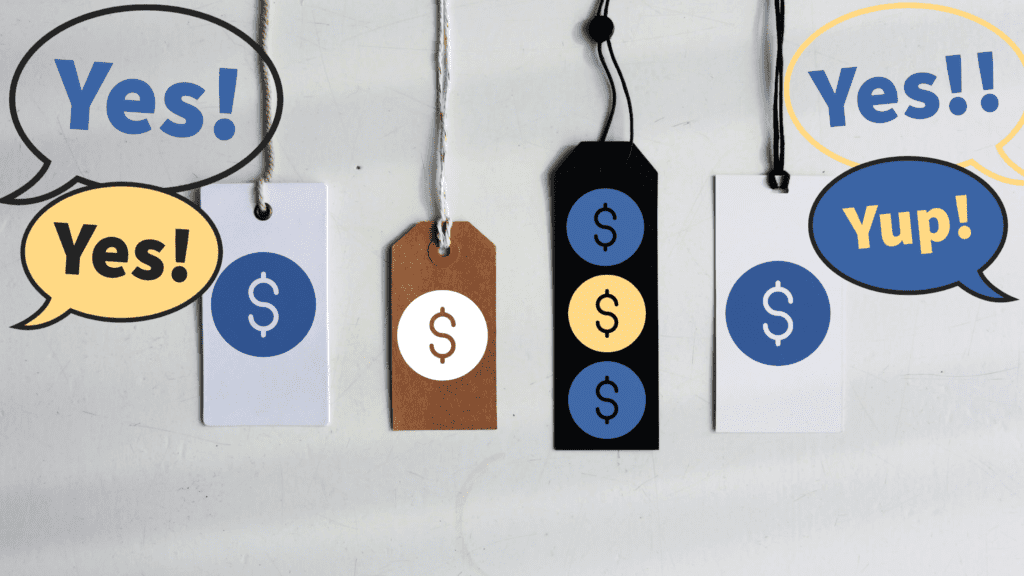
By pricing based on value, your customer will actually negotiate higher pricing for you (even if they originally planned to lowball you) which is how you increase your profits and create repeat customers.
The Simple Truth: Most people approach pricing completely backwards and end up on the losing end with low sales and even lower profits.
The problem is that most people price based on their time & costs, rather than pricing based on the value your brand delivers to your customer.
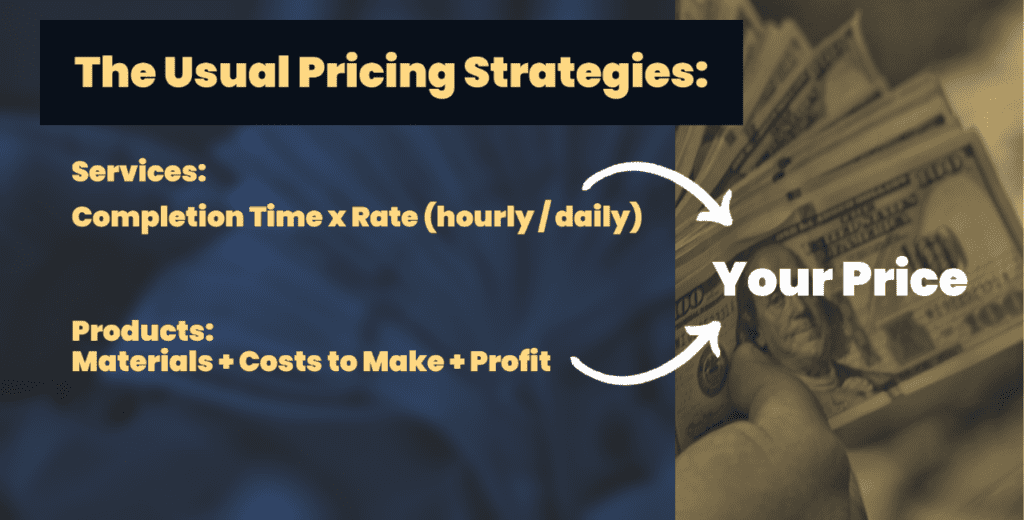
Customers EASILY can say no to (or dispute) these prices because the price is ALL ABOUT WHAT’S VALUABLE TO YOU, not them. Turn the tables towards what’s valuable to them and the conversation (and prices) switches instantly.
Here are five questions that instantly switches your pricing to value-based pricing:
- What problem(s) are you struggling with?
- Which problem creates the greatest impact if solved?
- How much money would you save/make if you solved that problem?
- How much would you pay to solve your problem?
- What would you like to do?
Let’s dive in⚡
Question 1. What problem(s) are you struggling with?
Don’t talk money, price or scope first.
These are actually the last items you cover.
Most brands start with price and scope first (especially service brands).
Don’t be like most brands.
You want to first uncover the customer’s Desired Future State.
By asking what problem(s) they’re struggling with, you open the conversation to find out what they want for the future and what they believe is stopping them.
You can use a FREE simple tool like Google Forms to ask the questions and get the answers.
Just make sure to capture EVERYTHING they say.
💡Pro Tip:
If they say {{This Thing}} is a problem, ask “why?”
Asking “why” gets the customer to open up more about the core issues they’re facing and their core desires for the future.
Now that you have their problems — resist the urge to immediately solve and hit them with a price — that’s coming later on.
Question 2. Which problem creates the greatest impact if solved?
Help them define the successful solution in measurable numbers.
Also, determine if they are wanting to gain something or get rid of something.

Let me explain:
Are they trying to reduce a thing?
• lost business deals?
• taxes owed?
• headaches?
• body fat?
or are they trying to increase a thing?
• sales?
• productivity?
• engagement?
• muscle mass?
Whatever it is, help them identify “the thing”, then quantify it by putting a measurable number to it:
⚡Here’s some examples:
• get 20 more sales per week
• set aside 5 extra hours per week to read
• lift 50 more pounds
• pay 50% less taxes
• lose 30lbs of fat
The impact needs to be a measurable number so the customer s (and you) can see later on how well your solution worked — THIS is called their success metric.
Make sense? On to the next question:
Question 3. How much money would you save/make if you achieved success?
This question helps your customer uncover the monetary value of success.
You have to convert their success metrics to money to establish value.
If they’re trying to increase “a thing”, ask:
• How much additional money would they make?
If they’re trying to reduce “a thing”, ask:
• How much time would you save (convert the time to dollars)?
• How much have you spent to solve this in the past?
• How much does the problem cost you?
You have to walk the customer through this, step by step.
But, what if their success metric has nothing to do with money?
Look at what the customer or other customers in their market pay to solve the problem – or the money they stand to miss out on by not solving their problem.
Example: lose 30lbs of fat
This success metric has no monetary value but there are monetary costs to losing weight:
• gym memberships
• diet food & supplements
• home gym equipment
Add these up and you now have a monetary cost the customer may want to reduce.
💡This dollar figure is the perceived value of the solution to their problem.
You’ll need the perceived value for the fourth question…
Question 4. How much would you pay to solve your problem?
The goal is to get the customer to agree to a fair budget they’d be willing to pay to solve their problem — keeping in mind their perceived value of the solution.
Asking this question sets the stage so the customer has to think about what they’d be willing to pay for the value you’d bring (and raise the number if they originally planned to lowball you)
Here’s an example:
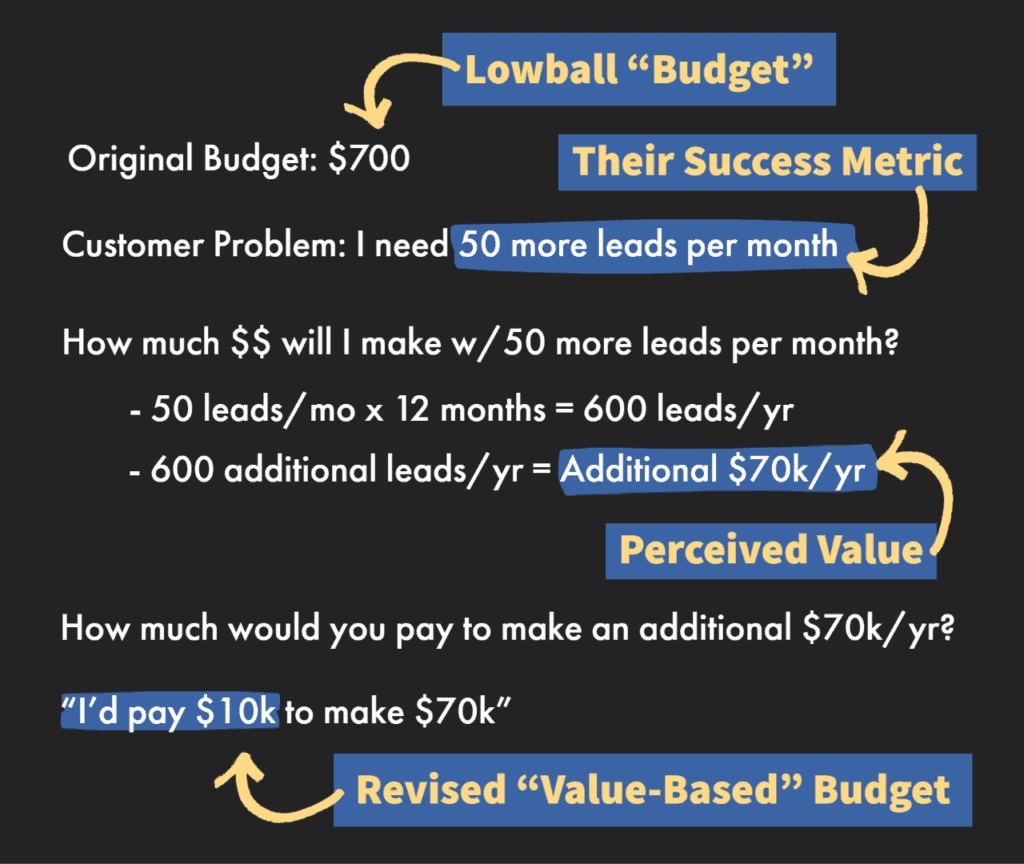
💡Even if they planned to lowball you, they have to negotiate against themselves now (and adjust their “budget”).
The powerful part is they’ve been doing all the talking (even if it’s to themselves). They said it, not you.
Here’s a great quote & strategy:
“When you say it, You’re selling. When they say it, You’re closing” — Chris Do
They said what their problems were — not you.
They said which problem would have the most impact if solved — not you.
They said how much the solution is worth to them — not you.
💡 And notice we still haven’t talked YOUR actual pricing.
The conversation has been totally about the customer, not you.
And now they’ve given you a REAL value-based budget , not an arbitrary dollar amount.
NOW on to the final question (where YOU finally come into play):
Question 5. What would you like to do?
THIS is where scope and price finally comes in to play — where you finally make an offer (aka the sell).
Offer a price that lands close to the value-based budget.
Let them know you can send over a contract stating as much (for services) or send them where they can start the ordering process (for products).
Then ask, “What would you like to do?”
Provide a service?
Send over the contract (not a proposal or estimate).
Sell a product?
Send them to the sales page.
It’s that simple. You’ve already determined and “agreed” upon a price they’d pay to solve their problem.
💡Note: If you sell a product you generally have to ask these questions to a bunch of people way ahead of time (preferably long before you ever make the product).
Then set your price & make your offer on the sales page.
So here’s the big question you still may have:
How to deal with stubborn Lowball prices?
A lowball price is the low price a customer thinks something should be based on the costs of a product or service.
Lowball prices come from “guess-stimating” how many hours it takes to make something or provide a service multiplied by an hourly rate or how much something costs to make.
Lowball prices do not consider the value (and profit) a product or solution provides.
By going with the value-based method, the lowball price usually disappears — but if it doesn’t, try these:
Get them to negotiate against themselves
Remind the customer about the value solving this problem creates for them — their perceived value in Question 3.
This usually gets a customer to raise their lowball budget.
If that doesn’t work…
Give multiple options, not just one.
Offer Low, Mid & High options.
There’s a reason most products and services have many options. It’s not just for personalization — it’s a pricing strategy.
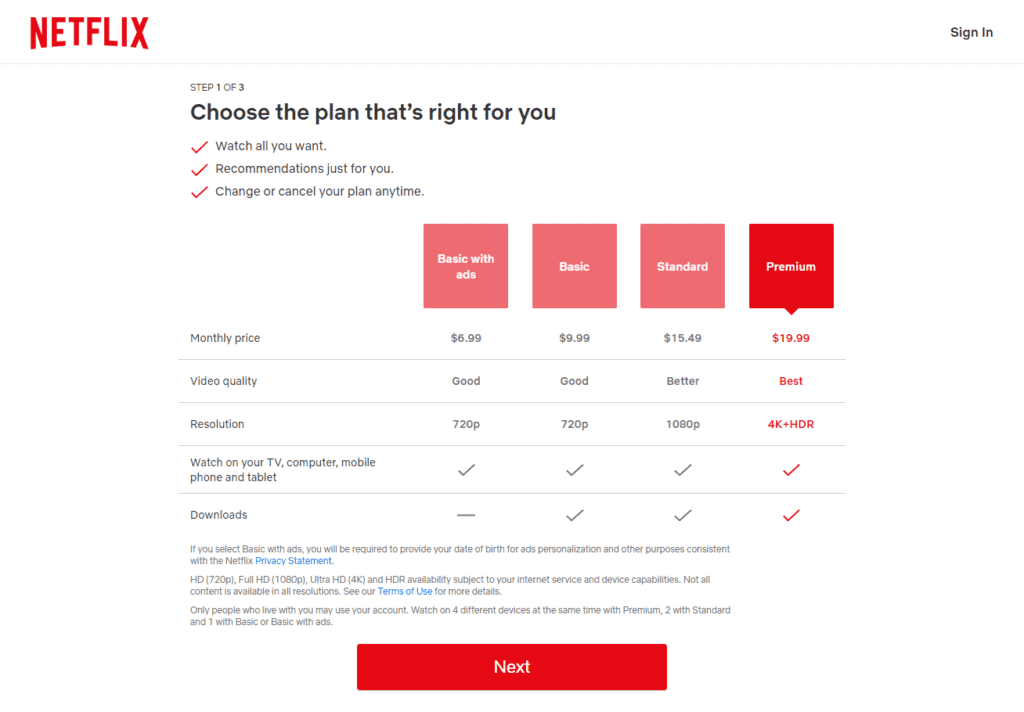
⚡Here’s an example of how it works:
How to sell a $10k watch?
The easiest way to sell a $10k watch is to display it next to a $100k watch.
Suddenly $10k (although it’s a lot for a watch) doesn’t seem nearly as expensive next to the $100k watch.
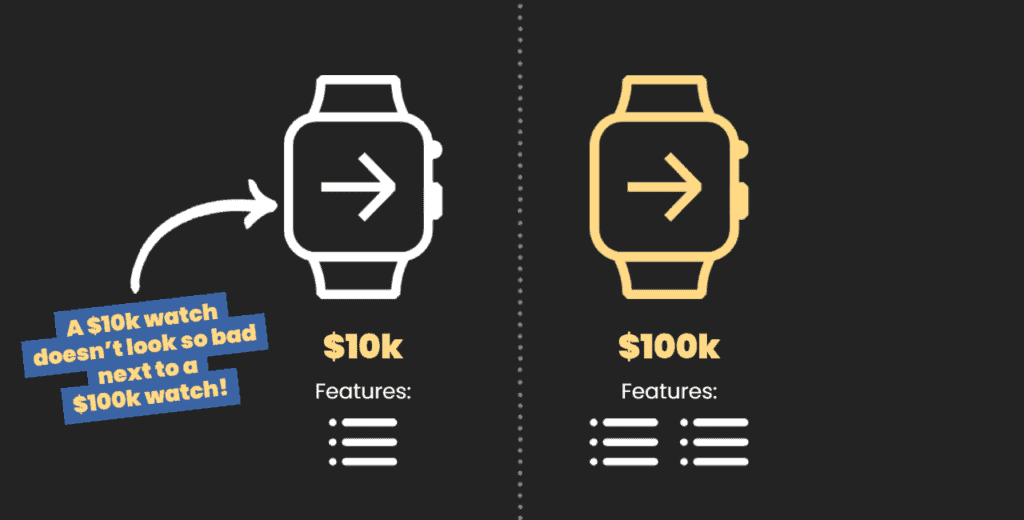
And suddenly you’re no longer focused on just a $10k price tag — you’re focused on which watch does the best job at providing the value you need — it shifts the conversation in the customers mind.
(Read that again 👆🏾 and let it sink in)
Low Option: lands close to their lowball number. This won’t likely help reach their goals, but will present a lower price that will produced results on a much smaller scale.
Mid Option: lands a little below the perceived value of the solution to their problem. Solves all the issues associated with their greatest problem.
High Option: far exceeds the perceived value they’ll get. Provides them with more than adequate relief of their problem.
I use the “three options tactic” often — here’s an example.
Annndddd if that doesn’t work…
Walk Away (Run!)
Sometimes even with all the right questions and the logic behind your offer, customers still will won’t budge on the lowball price in their head.
Yep — some people are just more concerned with what you’ll make rather than what they’ll get.
And so you have to say “No thank you”.
No hard feelings.
Just say no.
To make this easy and painless, here are 10 templates to say no without sparking a confrontation or feeling guilty about it.
Wrapping Up
This strategy works like clockwork for me and MANY other entrepreneurs and side-hustlers.
It completely shifted the way I approach pricing and negotiations and skyrocketed what I could charge for my services and products.
Put this to work for yourself ASAP and let me know how well it works for you.
Peace and Love,
Jesse “All About the Value” Young El
PS:
Whenever you’re ready, there are 3 ways I can help you:
- Twitter Tips: Get daily actionable tips
- Actionable Articles & Guides: Learn strategies to innovate, cultivate & convert your best ideas into income streams.
- Deep-Dive YouTube Guides: I’m making documentaries on content creation, disruptive tech & growth — Subscribe so you won’t miss a video!
